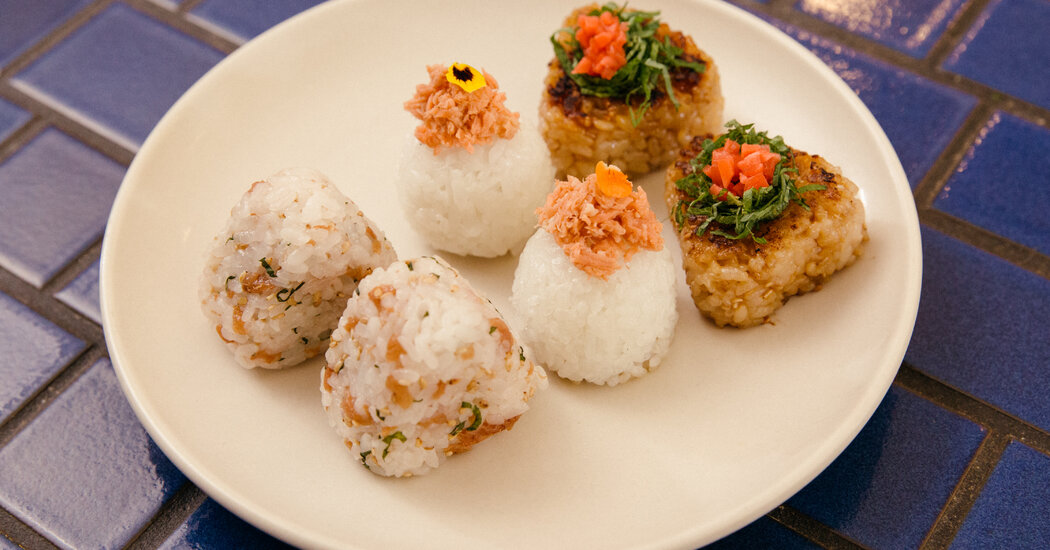
LOS ANGELES — I get loyalty cards from nail salons, coffee shops and carwashes, but the only one I can ever keep safe is from Jichan’s Onigiri-ya in Monterey Park. The busy rice ball shop sells warm, tender, generously filled onigiri shaped to order, and after collecting 10 stamps on its cards of goofy, grinning, cartoon onigiri, diners get a single rice ball on the house.
It’s just a few bites, but it’s a thrill. Will my bonus onigiri be stained purple with salty, pickled plums, and wrapped in a giant, frilly-edged perilla leaf? Or will it hold a piece of silky broiled salmon, the edges of the rice dark and crisp from the grill? I’m drawn to the onigiri made with rice that’s soaked in dashi, but if the pickled eggplant onigiri is on the menu, everything else just fades away.
When Jichan’s owners, Joe Miyano and Akira Yoshimura, were growing up, onigiri was their comfort food. Mr. Miyano’s grandfather, who grew and pickled his own plums in Chiba, shaped onigiri with homemade umeboshi for his grandson’s breakfast. The owners were also inspired by Musubi Cafe Iyasume, a chain that specializes in Hawaiian-style rice balls, known as musubi.
They wondered why fresh onigiri weren’t more commonly found on restaurant menus, and weren’t valued like the nigiri capped with slivers of fish at sushi bars.
Though nigiri and onigiri share a similar technique — hand-formed pieces of rice — the two are completely different. In part, that’s because of the way the genres are generally perceived — one luxurious and professional, the other inexpensive and domestic. In her book “Rice Craft,” the writer Sonoko Sakai put it this way: “Sushi is made by a chef; onigiri is made by moms.”
Though that rule has plenty of exceptions, it may help to explain the divide. While there are regional (and household) rice ball traditions, onigiri is driven by the playfulness and practicality of home cooks.
Your favorite pickle in the fridge? Chop it up and put it in some onigiri. A tiny piece of fish from yesterday’s dinner? Season it with some yuzu juice and a little mayonnaise and put it in some onigiri, stretching it into a new meal.
One of my favorite rice balls at the moment is the simple ume shiso onigiri, or the crunchy hemp and chia seed onigiri, at Super Rich, David Wynn’s onigiri shop in Echo Park. I love how if you’re taking the food to go, the kitchen packs large sheets of nori separately, so you can wrap at your leisure, and the seaweed doesn’t get soggy.
Part of the appeal of onigiri is that it’s so portable. If made with thought and care, a good rice ball won’t deteriorate after a bumpy ride in the car, or a little time in the refrigerator. When Mr. Yoshimura visited 7-Eleven locations in Tokyo, he was struck by the hanjuku nigiri in their aisles — a marinated, soft-boiled egg, strapped to a seasoned rice ball with an extra-wide seatbelt of nori. It inspired Jichan’s onsen nigiri, with its soft, sticky, molten yolk.
Still, the best onigiri is always just-made, still warm, the rice tender all the way through. The form holds, the grains cling together, but lightly. The rice hasn’t been smushed. The rice hasn’t been overcooked, either. The rice has absolutely no bite, but it’s not remotely mushy. It’s not that the fillings don’t matter, it’s just that the rice matters most.
Most onigiri shops use sushi rice, or some variety of short-grained sticky rice, and it’s not unusual to see large, singing rice cookers on their counters. Jichan’s kitchen works with Tamanishiki, a short-grain rice they were thrilled to find growing locally. (Mr. Miyano referred to it as “the Rolls-Royce of sushi rice.”) And at Super Rich, Mr. Wynn uses a blend of imported Akitakomachi and Koshihikari rice.
Rike, a sleek onigiri shop in downtown Los Angeles, shapes its onigiri with pearly Yukitsubaki grown in the Niigata Prefecture. Hisato Takenouchi, who owns the Japanese accessory brand Nana-nana, opened Rike in 2019, and his shop’s well-groomed onigiri almost give his fashion background away. The rice balls are unusually dainty and pretty, minuscule compared with the hulking musubi I love with thick slices of Spam, or the onigiri wrapped around fried chicken thighs.
Rike’s rice balls are teeny, filled with shreds of mock meat dressed in curry sauce, or flecked with shiso. They demand a photograph, by the window, in the good light. But this isn’t a complaint as much as an advisory: Order a few extra.
Jichan’s Onigiri-ya, 1975 Portrero Grande Drive, Suite A, Monterey Park, Calif.; 626-782-7754; jichansonigiri.com
Rike, 228 East First Street, Los Angeles; 213-265-7673; rike-dtla.com
Super Rich, 1814 West Sunset Boulevard, Echo Park; 213-822-2103; superrich.la



